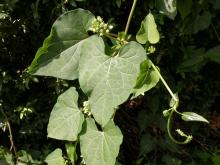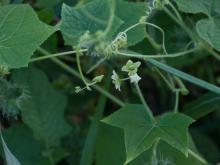Wildflowers, Grasses and Other Nonwoody Plants
Media

Species Types
Scientific Name
Ludwigia peploides
Description
Water primrose is a common shoreline plant with bright yellow flowers and long, trailing stems. It grows in dense mats in the shallow areas of ponds, lakes, and streams.
Media

Species Types
Scientific Name
Galium aparine
Description
The tiny white flowers of this native plant are not very memorable, but the curious, sticky-feeling whorls of narrow leaves and lightweight, 4-sided stems make cleavers unique. And then there’s the tiny, round, “Velcro” covered balls of the seeds, which “stick tight” to your socks!
Media

Species Types
Scientific Name
Fallopia scandens (formerly Polygonum scandens)
Description
Climbing false buckwheat is a rampant, native, annual or perennial climber that often forms curtainlike masses of twining red stems, covering shrubs and trees. Look for it in moist, open or shaded bottomlands, alluvial valleys, and floodplains.
Media

Species Types
Scientific Name
Ipomoea pandurata
Description
Wild potato vine is related to the sweet potatoes we buy at grocery stores. This native vine is also related to the morning glories that decorate trellises and to the bindweed that plagues gardeners and farmers.
Media

Species Types
Scientific Name
Calystegia sepium (also Convolvulus sepium)
Description
Instantly recognizable as a type of morning glory, hedge bindweed is common in disturbed habitats and can be a serious agricultural weed, but it is not as problematic as its relative field bindweed.
Media

Species Types
Scientific Name
Cynanchum laeve
Description
Bees, butterflies, and other insects love its nectar, but sand vine is also a problem weed that can be difficult to eradicate. Some people cultivate it as an ornamental. Beekeepers value it as an excellent honey plant.
Media

Species Types
Scientific Name
Cuscuta spp.
Description
Dodders are easy to identify, even though at first you might not recognize them as plants. These parasitic plants usually look like a hairlike mass of yellow or orange, leafless, wiry, vining stems wrapping around the stems of other plants.
Media

Species Types
Scientific Name
Sicyos angulatus
Description
Bur cucumber is a nonwoody, native, annual vine common in low, moist soils. It can spread across an area 20 feet wide, covering the ground and nearby shrubs. Note its lobed, gourd-family leaves, curly green tendrils, clusters of prickly, green, oval fruits, and 5-lobed, cream-colored flowers.
See Also
About Wildflowers, Grasses and Other Nonwoody Plants in Missouri
A very simple way of thinking about the green world is to divide the vascular plants into two groups: woody and nonwoody (or herbaceous). But this is an artificial division; many plant families include some species that are woody and some that are not. The diversity of nonwoody vascular plants is staggering! Think of all the ferns, grasses, sedges, lilies, peas, sunflowers, nightshades, milkweeds, mustards, mints, and mallows — weeds and wildflowers — and many more!





















